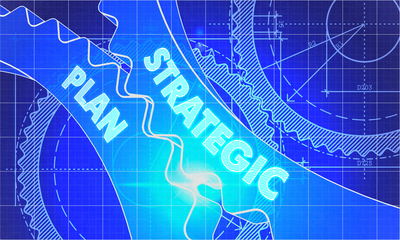In STILE Point 23, we provided an overview of the 7 steps to developing a winning strategy shown in the figure below. The strategic planning process starts with the development or updating of the organization’s mission, vision and values and finishes with a strategy designed to fulfill its mission and achieve its vision. The mission is usually a variation of developing, deploying and exploiting science and technology to create value for the organization depending on the industry sector. In the case of government research institutions, the mission is often expanded to include recommending policies and commercializing technologies based on sound science to stimulate economic and social development.
 STEP 1 SELF ASSESSMENT: A thorough understanding of the organization’s strengths, weaknesses and assets/resources available to it.
STEP 1 SELF ASSESSMENT: A thorough understanding of the organization’s strengths, weaknesses and assets/resources available to it.
STEP 2 COMPETITOR ANALYSIS: The strengths, weaknesses and strategy of competitors’ products and services fighting for the same market space.
STEP 3 CLIENT FEEDBACK: Gaining Intelligence from existing clients on their current problems and future opportunities and the value you bring to their organization.
STEP 4 TECHNOLOGY TRENDS: An awareness of competing and emerging technologies that could disrupt the strategy.
STEP 5 MARKET ANALYSIS: A thorough knowledge of market and industry trends.
STEP 6 STAKEHOLDER REQUIREMENTS: A clear understanding of additional stakeholder requirements which could include regulatory, political and social factors that could positively or negatively affect the organization’s license to operate and its brand image.
STEP 7 STRATEGY SYNTHESIS: Collecting and synthesizing the disparate data and information in steps 1-6 into actionable intelligence on which to make decisions.
In previous STILE Points, we elaborated on the six data collection steps; self-assessment; competitor analysis, client feedback, technology trends, market analysis and stakeholder requirements. In the current STILE Point, we culminate this process with the synthesis of this data to develop a winning strategy.
The strategic planning process starts with the development or updating of the organization’s mission, vision and values and finishes with a strategy designed to fulfill its mission and achieve its vision. Strategic planning involves developing a vision (where you want to go); a strategy (how you are going to get there); and a resource plan (identifying all of the resources you need at the right time and the right place). It takes into account all of the potential barriers and resource constraints you can think of that you might encounter and develops alternative scenarios that potentially can overcome those barriers.
Armed with the information obtained in the first six steps of the planning process, an organization’s leadership team can then develop a business strategy consisting of several thrusts designed to allocate its limited resources to protect and exploit its technologies; compete in a favorable market space, and recruit and retain top-level talent. The most important focus of the strategic planning process is making decisions on where to allocate scarce resources. Too many organizations get bogged down on the process and writing the plan and lose sight of the real importance of the planning process which is to make tough decisions about where to allocate resources.
Mission, Vision, and Values
Before discussing strategy, it is important to clearly define the organization’s mission (why do we exist?); vision (what do we want to become?) as well as values (how should we behave?) that will ultimately determine its culture.
The mission is usually a variation of developing, deploying and exploiting science and technology to create value for the organization depending on the industry sector. In the case of government research institutions, the mission is often expanded to include recommending policies and commercializing technologies based on sound science to stimulate economic and social development.
The vision describes the aspirations of the organization that defines success. It is usually defined in business terms such as capturing market share, growth in revenues, and creating shareholder value. Equally as important is how the organization will improve the human condition through the development and exploitation of science and technology.
Organizational values are then developed that identify the behaviors necessary to support the mission and vision. This often overlooked step is critical to shaping the organizational culture essential for success. I have copied Johnson and Johnson’s Credo at the end of this STILE Point which exemplifies the balanced scorecard approach mentioned in a previous STILE Point on Meeting Stakeholder Needs and is one of the best value statements I have ever read that also captures its mission and vision. Having had Johnson and Johnson as a client, I can attest to the importance of the values in the Credo. Whenever there was a difference of opinion or point of contention as to a specific decision to make or direction to pursue, The Credo would be pulled out and read aloud to help the competing staff make the best decision possible.
Developing a Strategic Agenda
One you have finalized your mission, vision, and values, a strategy can be developed to fulfill your mission and achieve your vision. As stated previously, the essence of a winning strategy is to make decisions about what to focus on and where to invest your limited resources. This will result in a competitive advantage given the information and data gathered in the first six steps of the planning process. I prefer the term strategic agenda rather than strategy as there are several strategic thrusts that must be simultaneously pursued in order to achieve one’s vision.
Based on the information obtained in steps one through three, you should have a pretty good idea about your current state; i.e. where your products/services stand with your client base versus your competition. Your vision statement provides you with a clear idea of a proposed future, desired state. A strategic agenda represents a road map that takes you from your current state to the desired state. you must identify specific thrusts to pursue that closes the gap between your current and future states. The thrust areas should address your current and future clients, products/services, processes, staff, and stakeholders and have specific identifiable outcomes that can be measured. Before we elaborate on the thrust areas themselves, there are several general comments that that need to be taken into consideration.
First and foremost is to determine the degree of change that may be necessary to get from the current state to the desired state. If you are currently an industry leader, you may only be looking at incremental change to effectively maintain your position in the marketplace. If you sense that there are pending technology trends, market trends or competitor initiatives that may threaten your leadership position, you may need to plan for a more progressive, evolutionary change. If you are not in a position of leadership and see your business threatened by any of the above, you may need to develop a revolutionary approach to transform your current business in dramatic ways. Clearly, when moving from incremental to evolutionary to revolutionary change, the thrust areas become more difficult and the risk level increases dramatically. Having led several “turnarounds” requiring transformational change, I can attest to their difficulty.
Next, it is important to place your strategic thrusts and resulting outcomes in context. Your competition also has their strategy with which to beat you in the marketplace so you must measure your progress versus your competitor’s both relative to your current competitive position and the relative rate at which you are both improving.
Another consideration is to take into account the ability of the organization to successfully implement the strategic thrusts by critically examining the self-assessment developed in step one. Many good strategies have failed due to a lack of appreciation for the difficulty in implementation, particularly during a transformational change. The barriers are many including organizational policies and culture, leadership talent and commitment, competitor counter moves and lack of anticipated resources.
One way to mitigate surprises during the implementation of your strategic agenda is to develop several scenarios that test the robustness of the strategy. I have found these “what if” scenarios to be very useful in terms of developing work around contingency plans that can be incorporated into the planning effort. At least three scenarios should be developed: an optimistic scenario which represents the successful implementation of each of your strategic thrusts: a pessimistic scenario driven by disruptive new technologies, market trends, regulatory hurdles or organizational barriers: and a most likely scenario in the middle. An additional benefit from scenario development and contingency planning is the consensus that it can built among the leadership team involved in the planning effort.
In future STILE Points, we will roll out a strategic agenda focused on five main imperatives: market strategy, product strategy, resource strategy, regulatory strategy and stakeholder strategy and suggest specific strategic thrusts for each of them.



